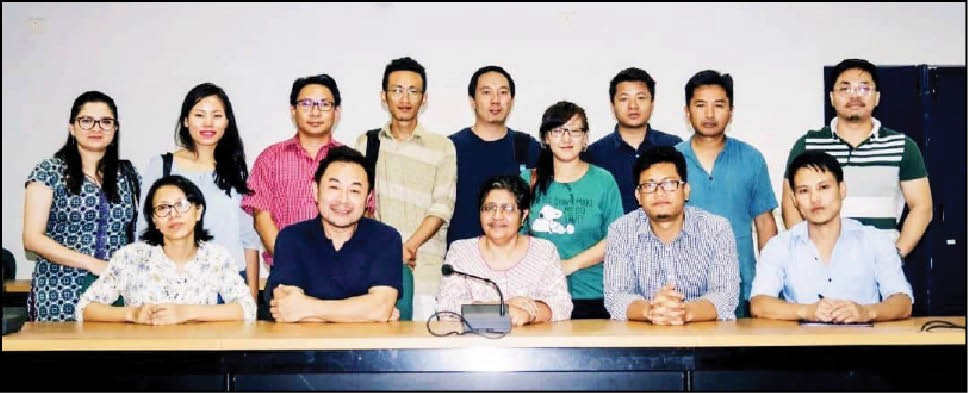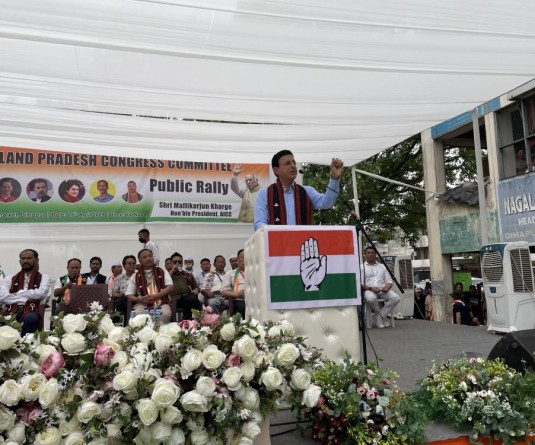Participants during the ‘Research Scholars Colloquium’ organised by Naga Scholars Association at School of International Studies (SIS), JNU, New Delhi on May 17. (Photo Courtesy: NSA)

Dimapur, May 18 (MExN): The Naga Scholars Association (NSA) organized ‘Research Scholars Colloquium’ at School of International Studies (SIS), JNU, New Delhi on May 17.
The Association stated in a press release that Dr. Zuchamo Yanthan, president, NSA started with a welcome address and the introduction of the speakers and the chairperson Dr. Susmita Dasgupta, a chief economist at Joint Planned Commission, Ministry of Steel, an author of several books of international repute, an economist as well as a sociologist.
‘Environmental injustice in Ukhrul District’
The first speaker was Dr. Mirinchonme Mahongnao who presented a paper on the topic ‘Environmental injustice in Ukhrul District, Manipur.’ Dr. Mirinchonme started with the argument that everyone is equally entitled to accesses to the benefits of natural resources but not at the cost of injustice. It is in this context the speaker tried to elaborate on the concept of distributive and procedural justice taking the case study of mineral mining (Chromite) in Ukhrul district, Manipur.
According to him, the actual risk of mining is borne by the native/indigenous since most of the Chromite mines are located adjacent to the river and its tributaries, which are the main water source for their livelihood. Hence one of the immediate consequences of chromite mining is the possible contamination of the river itself. So, it not only violates distributive justice by denying the tribal communities of the benefits from the extraction of such resources, but also imposes injustice in the form of health hazard and environmental destruction.
With regard to the procedural justice, the speaker argued that the companies undertaking the contracts of exploiting the mineral resources do not follow the necessary ‘Environmental Impact Assessment (EIA)’ procedure, which results in legal loopholes in the process. Consequently, the impact of Chromite mining and its larger ramifications on environment is negated. Hence, he emphasized on the importance of EIA in any projects that involves environmental consequences.
‘Understanding America: Contesting the liberal projection of America’s image’
The second speaker was R. Eknee C. Khongrei presented a paper on the topic ‘Understanding America: Contesting the liberal projection of America’s image’. He began by contesting the distorted image of America by the liberals, whom he argues comprises of the minority community that has influenced the image projection of America. He traced the American history in the context of the three waves of immigrations that followed which in the process change the narrative of American identity.
He further stated that the third wave was the most significant wave because this was the beginning of the negative construction of American culture, who did not assimilate themselves to the existing American culture. More importantly the proliferation of this third wave immigrants resulted in impacting the political dispensation, who became an important vote bank. Their influence in the political process gave them opportunity to legitimize their popular culture, which later on dominated the popular American identity. This according to him is a one-sided projection of America’s image.
Subsequently, the third wave immigrants engineered a split within the Protestant Christian community resulting in the emergence of the Democrats (Liberals) and the Republicans (Conservatives), two of the most influential political parties in America. Consequently, the emerging social issues like that of Homosexuality and gender identity, the popular Hippies movement and so on were ways of rebelling against the existing American culture. Hence, he concluded by arguing that American identity projected from the lenses of the liberalist should not be validated as the only image of the Americans.
‘Substance abuse prevention among adolescents: what works and what doesn’t?’
The third speaker was Dr. Kaisolo Pazhüni presented a paper on the topic ‘Substance abuse prevention among adolescents: what works and what doesn’t?’ The speaker started with a statement that substance abuse has gained rampancy and the consequences of which affects not only the individual but has a chain effect on the family and society at large. Tobacco, alcohol and drugs (cannabis/marijuana) are the main substance abuse indulged by the adolescents.
The speaker revisiting her field work in Manipur, found that substance abuse (tobacco and alcohol in this case) initiation were not necessarily limited to the older adolescents but even children as young as 6 years of age were influenced. Her research work came out with a finding that more than peer group even siblings are the main source of influence upon the adolescents for indulging into substances. It is also found that most adolescents indulged in substances due to peer pressure, curiosity and fun sake.
She evinced, using National Family Health Survey (NFHS) data that the rate of substance abuse users has increased both among the male and female in the northeast region and significantly among the female group (tobacco in their case). With regard to preventive interventions by the government and others in the community, school and village levels, she argues that scare tactics and employment of force has resulted in negative output whereas social influence, social empowerment approach by way of encouraging coping mechanisms and life skills resulted in positive outcome.
Lastly, she emphasized that it is easier for attitudinal change in substance users rather than behavioral change based on her field survey because behavioral change according to her is a gradual process that takes times in withdrawal. She concluded by emphasizing that there is a need to raise larger awareness with regard to encouragement in intervention changes.
The chairperson Dr. Susmita Dasgupta gave remarks on all the paper presenters with suggestions for further improvement of their research papers. It was followed by question and answer and discussions.



